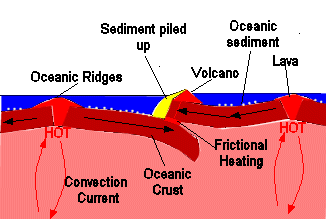DAY THREEThe earth eventually cooled sufficiently for a crust of considerable thickness and rigidity to form. Convection currents in the upper mantel below the crust began to slow down. The diagram below shows how the first land may have been formed:
 The oceanic plates were broken up by convection plumes. Where plates slipped away from the hot domed zones oceanic ridges formed. Between the hot domed zones tension fractured the plates and part of the fractured plate will be forced down and the other part up. The movement of one plate above the other scraped up such sediment as was on the ocean floor. The sediment consisted of dust, ash and dead marine organisms. Volcanic action produced by frictional heating also contributed to the emerging land. Once land was formed in this way conditions were conducive for colonisation by plants. The Genesis account makes it clear that the plants that evolved at this stage were seed bearing plants. The early simple microscopic plant life of the oceans prepared the way for these more complex land plants. The very warm, very humid climate and the high concentration of carbon dioxide in the atmosphere were all ideal for plant growth. There was no direct sunlight. Some wavelengths of light were scattered out and others absorbed. I wonder if the light conditions at the time plants arrived on earth might have something to do with their green colour. The lush plant growth reduced the carbon dioxide content of the atmosphere and increased dramatically the oxygen levels. This was vital for the success of the next stage of creation. |